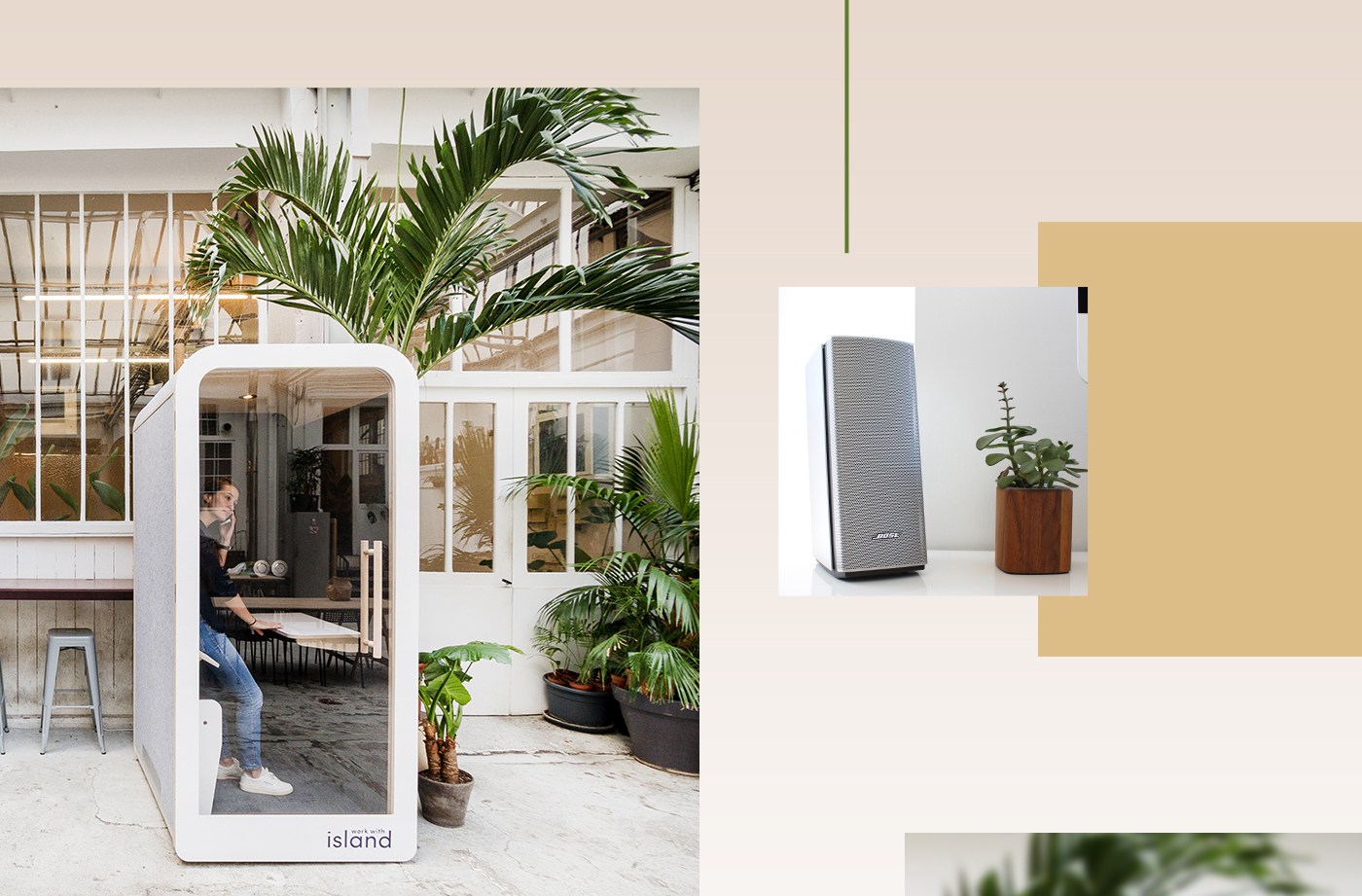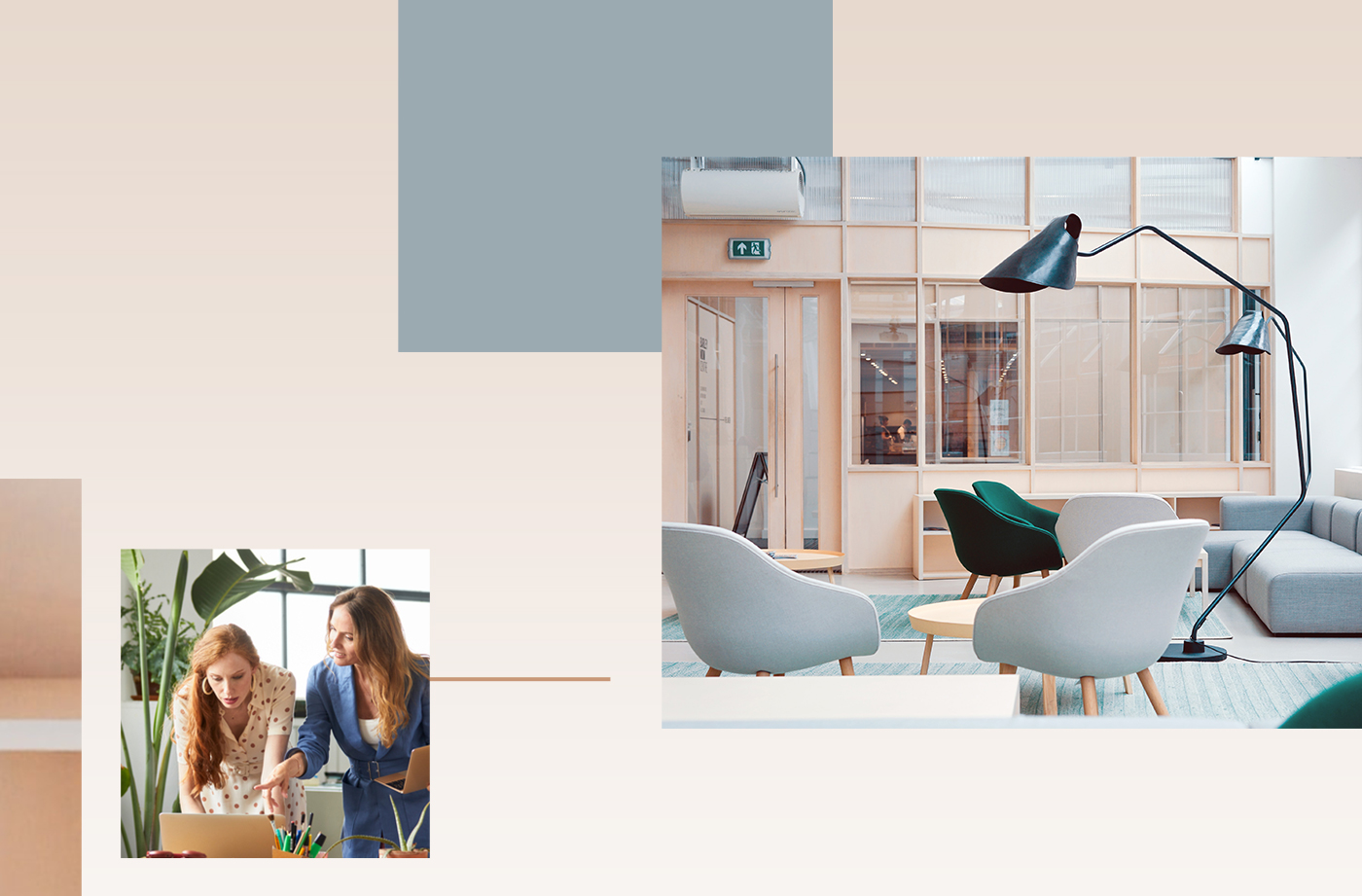In the Future, Office Design Plans Will Prioritize Employee Wellness
Workplace design has come a long way in the past decade, as a growing number of companies have started swapping cubicles, unsightly wheeled chairs, and fluorescent-lit break rooms for communal workstations, velvet sofas, and cafés with cold brew on tap. But as we enter the 2020s—with the rising issue of burnout making workplace wellness a top issues for employers to consider—how will office design ideas continue to evolve in a way that doesn't just appeal to workers' aesthetic sensibilities, but also helps them stay healthy?
To answer that question, it's key to first consider how we got to this place of offices looking like high-end hotel lobbies and offering many of the same amenities as boutique gyms. "I think a couple of factors go into it," says Alda Ly, the architect behind The Wing's 10 co-working spaces in the United States and United Kingdom. "One is intense competition for talent. Employers are realizing what their office looks and feels like matters to employees and is integral to hiring and retention." Research supports her theory: In a 2018 study of 1,000 British workers, 43 percent said they have rejected a job offer because of uninspiring office design. Other research has found that employees who are happy with their physical work environments are 16 percent more productive and 18 percent more likely to stay at their jobs than those who aren't.
"Employers are realizing what their office looks and feels like matters to employees and is integral to hiring and retention." —Alda Ly, The Wing architect
Companies such as Facebook and Google set the wellness precedent that so many others are aspiring to today, says Rachel Gutter, president of the International WELL Building Institute, which certifies properties that advance health and well-being initiatives. "Offering all of these amenities and benefits above and beyond a great paycheck and solid benefits with things like massages and scooters and rock-climbing walls and unlimited food reconditioned [the millennial] generation and reset their expectations," she says. "That put additional pressure on [all employers] to offer up something similar."
Still, many of those early pushes toward workplace wellness were nothing more than "vanity measures," Gutter says. "Oftentimes, they may have been speaking to an issue that was not even close to the most pressing issue an organization was facing." Indeed, a recent Harvard study of 1,600 workers found that shiny-object perks like gyms and tech-based toys were the least coveted among a list of nine wellness-related office-design ideas. The things that mattered most to the employees surveyed? Good air quality and access to natural light.

{{post.sponsorText}}
To this end, forward-thinking employers are now prioritizing design features proven to positively impact workers' well-being and productivity. Below, find out exactly what that means for the future of how our office spaces will look.

How office design will address burnout
Burnout is one of the biggest issues facing employees today—it's so rampant, in fact, that the World Health Organization recognized it as an occupational phenomenon in its International Classifications of Diseases this year. While there are many factors that contribute to burnout, some of the most common include an unmanageable workload, feeling out of control, and lack of community at the office.
Clearly, these complex problems require multilayered solutions. "You can't design your way out of burnout," says Gutter. "It's got to be a combination of design and organizational interventions supported by leadership and culture. If you're going to have a mindfulness room, it's all for naught unless you have an organization that encourages people to take breaks throughout the day." Even so, there are ways to help reduce employee stress levels through design.
Solution 1: biophilic design principles
One such strategy involves bringing nature into the office environment. Take, for instance, a study of 7,600 global workers that found when offices incorporate plants, natural light, and water features, they were linked with 15 percent higher levels of employee well-being.
"We’re devoted to integrating biophilic design principles, which aesthetically bring a sense of natural beauty and serenity to spaces, but more importantly, make spaces less stressful on employees, both psychologically and physiologically," says Ly. New York City co-working space The Assemblage is another adopter of the biophilia trend, with its two roof gardens, living walls, and trailing vines hanging from conference-room ceilings.
Solution 2: Decompression spaces and social zones
"Decompression spaces" is another way employers may address burnout in the future. "We’re increasingly seeing our clients provide spaces for employees that are for taking time away from work: break rooms that are tasteful and comfortable, outdoor spaces that provide time and space for reflection, rooms for quick power naps," says Ly, who also believes that hangout spaces will become more prevalent as workers realize the mental-health benefits of disconnecting from messaging apps and email to connect in person.
Designated areas for socializing and collaboration are also key as off-site working becomes more prevalent. "Working remotely is embedded into the culture of many companies, so the office becomes that place where you connect, interact and feel part of a bigger community," says Francesca Poma, senior associate and design director at architecture and design firm Gensler.

Open offices are staying around, but they'll be less of a drag
While about 70 percent of offices today have open floor plans, they come at a qualitative cost. A review of more than 100 studies found that this style of office design has a negative impact on attention span, creative thinking, productivity, and job satisfaction. (Not to mention, it's arguably contributing to burnout.)
Unfortunately for those who consider open offices to be the worst, designers don't expect them to go away any time soon. Gutter points out that given the growing density and cost of operating in cities, space is at a premium and employers need to make the most of every square foot, and open-office plans are certainly efficient with space. Luckily, they're also starting to evolve in a way that minimizes many of their less-than-desirable qualities.
1. Acoustic control
"One of the biggest complaints about open offices is the noise," says Gutter, noting that noise exposure has health implications as well—it's linked to a number of negative effects, including obesity and heart disease. "Proper acoustic design is part of the solution for open offices, particularly sound-masking systems that create a consistent ambient noise, almost like a white noise, so you have speech privacy. As much as it’s a problem when open offices are noisy, it’s a problem when open offices are super quiet." The goal here is for employees to not be bombarded by coworkers' conversations, and also feel comfortable enough to take phone calls without having to duck into a stairwell.
2. Flexibility in location and environmental factors
Companies are also starting to create different "neighborhoods" within open offices—for instance, quiet zones and areas with differing temperatures—and allowing employees to sit wherever they wish based on how they feel that day. "Flexibility is key, [because] we all have differences in our work styles," says Gutter.
Ly agrees that it's critical to create a variety of different environments within an open-plan office. "For a recent creative agency client, Blue State, our plan included open seating, but there was also substantial space devoted to a café-style lounge meant to foster creative, collaborative work, as well as quieter, more focused spaces such as phone booths and a library," she says. "The expectation is that employees will move through different environments throughout the day and not be confined to their desk chairs." She points to The Wing as an example of how open office spaces can feel both expansive and intimate as a result of dividing their vast spaces using color, texture, and furniture.
Furthermore, these varied zones lend themselves to increased productivity. "An open work area where people can interact spontaneously, meet people, and create a sense of community, along with more private spaces, like small meetings rooms and phone rooms, will make highly efficient and healthy spaces," says Poma.

'Invisible upgrades' will improve alertness and productivity
"A lot of the most exciting innovations in workplace wellness are things you really wont see at all," says Gutter.
Air quality, prioritized
For example, don't be surprised if more companies start bragging about the purity of their offices' air. A series of studies conducted in 2014 showed that improved indoor air quality boosted subjects' productivity at work and doubled their cognitive function, which is leading organizations to start prioritizing this element of healthy design. "We now know that excellent ventilation and superior air quality have a host of benefits—some of them pretty immediate to the health and productivity of our workforce," Gutter says.
Sleep enhancing lighting (yes, really)
Lighting is another office design element that's getting a lot of attention lately, partially for its link to sleep quality. One study of four companies found that sleep-related reductions in productivity cost a collective total of $54 million a year. "We have come to understand that exposure to daylight throughout the day has a substantial impact on the way that we sleep at night," Gutter says. So, expect to see a growing number of workspaces featuring circadian-rhythm lighting, which mimics the sun's natural shifts in light and color temperature throughout the day. Ly is excited about a different type of artificial light that mimics the feel of a real skylight, and she predicts that nature-inspired lighting solutions like this will continue to gain ground in the future.
Ultimately, says Gutter, we spend about a third of our waking hours in the workplace, so it makes sense that employers are investing in office design solutions that make those hours healthier for all involved. And in the future, there's no doubt that companies will increasingly realize what Ly and many other architects so strongly believe: "Having a space that promotes wellbeing is not 'cosmetic' or 'nice to have.' It’s actually critical."
While we're gazing into our interior design crystal ball, here's what the gyms of the future will look like. As for your own space? Here's how to improve your home's air quality to boost productivity.
Loading More Posts...